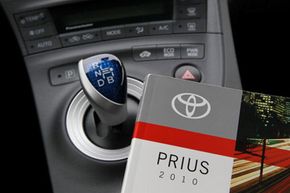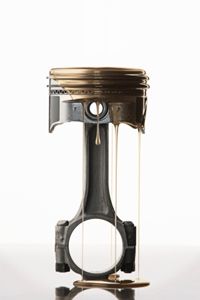The precise method for finding the oil capacity of a car may differ slightly from one car to another, but in general the available methods will be similar. To illustrate, we'll use the 2011 Toyota Prius as an example. To learn the oil capacity of the Prius, any of the following methods will work:
Look in the Owner's Manual. Most cars come with several manuals. For the 2011 Prius, the one you want to look in says "Owner's Manual" on the front. Yours will probably say something similar. On the Table of Contents page of the Prius manual, the section that tells you the oil capacity is Section 6 and is titled "Vehicle Specifications." Turn to this section and look for the text header "Lubrication System." This gives you the following information:
Oil capacity (Drain and refill)
- With filter 4.4 qt (4.2 L, 3.7 Imp. Qt)
- Without filter 4.1 qt (3.9 L, 3.4. Imp. Qt)
Notice that the information is given both with and without a filter, and in units of quarts, liters and imperial quarts. (Just the first two are likely to be useful if you're in the United States. Imperial quarts only tend to be used in the United Kingdom.) Below this, under the header "Engine oil selection," you'll find information on the grade and viscosity of oil that you should use.
Look on the manufacturer's Web site. For the Prius, you'd go to the Toyota Web site. At the bottom of the home page, point your mouse at "For Owners" and a pop-up list will give you access to owner's manuals and technical information sheets for any vehicle that Toyota sells.
Look on a Specialty Web Site. If you've lost your Owner's Manual or the manufacturer's Web site doesn't make it available, you can go to a Web site like the Oil and Fluid Capacities site to find the information you're looking for. On that site, click on the Fluid Capacity Lookup tab, then the Online Product Application Guide button. Type in your vehicle year where asked and click Build List. This will give you a long list of manufacturers and auto models. Choose Toyota Prius (or whatever vehicle you're looking for) and the specific engine type you have. (For the Prius, only "1.8L 4-cyl Engine Code 2ZR-FXEVariable Fuel" is available.) This takes you to a comprehensive list of not only oil capacities but all fluid capacities and types that the car needs. For the Prius, the line that you're looking for reads "Engine, with filter..........4.5 quarts." This figure is slightly (but not significantly) different from the one in the Toyota manual, probably due to numeric rounding.
Use your dipstick. To find out how close your car is to the recommended oil level, let the engine cool for five minutes, pull out the oil dipstick (which your manual should help you locate), wipe it clean with a rag, reinsert it and then pull it back out. The oil clinging to the end of the dipstick will show you the level of oil in your car's engine. If you turn out to be running low, add a little more until you near the top of the range. Try not to add too much, but a slight excess is probably okay. Most modern cars have dipsticks designed to leave a small amount of unfilled capacity above the full line so that you won't accidentally overfill.
Of course, there's a good possibility that the car you need to find the oil capacity for isn't a Prius, but for all other cars you'll probably find that the above methods basically apply.
For more information about engine oil capacities and other related topics, follow the links on the next page.




